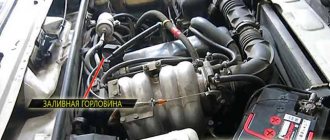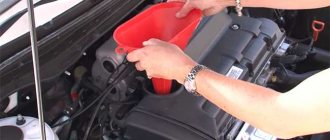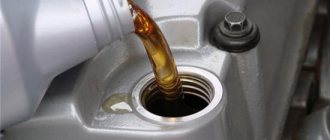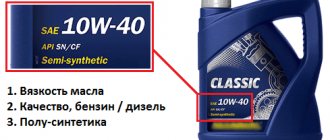The car engine must work smoothly, since the vehicle’s controllability on the highway depends on this. The moving elements of the motor require constant lubrication. Therefore, the lubricant level must be constantly monitored. Every motorist should know how to add oil to a car engine.
Before you fill in a lubricant of a certain viscosity, you need to find out what kind of oil fluid is currently in the car. If the car is already used, then information about the consumables can be obtained from the previous owner. It wouldn’t hurt to ask the former owner how often oil was added to the vehicle’s power unit? Next, all that remains is to fill in the grease of the required brand and viscosity. Additionally, you can delve into the machine's operating instructions and find out all the recommended information from the manufacturer.
Content
- Main functions of motor oil
- What is taken into account when selecting motor oil Manufacturer's recommendations
- Engine condition
- Type of equipment
- Preparatory stage
Its reliable and stable operation largely depends on high-quality lubrication of an internal combustion engine (ICE). Therefore, it is so important to top up engine oil in a timely manner if its level is below the minimum allowable level. Topping up can be done at a service center, but many motorists prefer to do it themselves.
Step-by-step instruction:
- park the car on level ground;
- let the car sit for several hours. This is necessary so that the mixture completely flows into the pan. Of course, if an approximate result is enough, then you can let the vehicle sit for literally 5-15 minutes;
- find the oil filler neck. It is located at the top of the cylinder head (cylinder head). It is usually easy to recognize by its pictogram in the form of an oil can with a drop;
- unscrew the lid and wipe it with a clean cloth or paper towel and set it aside;
- Now, using a clean oil dipstick, which must be inserted into the hole until it stops, you can check the lubricant level. As said earlier, the height of the grease should be between o and “max”. If the level is at the minimum mark, the mixture needs to be added accordingly.
What is taken into account when selecting motor oil
When choosing a lubricant for an engine, you should not rely only on your own preferences or be guided only by a low price. To select a motor oil with optimal characteristics, a number of factors should be taken into account.
- Manufacturer's recommendations
. In the instructions for each car model, the manufacturer always indicates the optimal viscosity of engine oil for winter and summer. The lubricant should be selected based on this characteristic. - Engine condition
. If the car is old and only mineral oil has been poured into its engine for many years, you should not replace it with synthetic oil. Synthetics are recommended for use on new cars. - Type of equipment.
When selecting a lubricant, the type of car must be taken into account. For example, for passenger cars, SINTEC offers a unique PLATINUM line with a package of multifunctional imported additives, for commercial vehicles - the TRUCK, DIESEL and other series, designed for vehicle operation in difficult conditions.
Service frequency
The frequency of service work on a car engine will directly depend on the type of engine.
Typically, manufacturers advise performing this procedure every 12-15 thousand kilometers. However, in Russian conditions, the fuel is not of the proper quality and contains various additives that enter the lubricant and deteriorate its structure, so it is recommended to change the oil every 2 years or every 8-10 thousand kilometers.
If a car owner neglects the recommendations of the car manufacturer or uses low-quality lubricant, this leads to premature wear, problems with valves and cylinders may appear, and the turbine often fails.
Such an engine will require an expensive overhaul or a complete replacement, so experts do not recommend saving on service by performing this work at a service station or independently using original filters and high-quality consumables.
How to properly pour oil into the engine
First of all, you should read the instructions and prepare the required amount of lubricant, selected according to the manufacturer’s recommended specifications. Motor oil should be purchased at specialized points where the seller provides a documented quality guarantee.
Preparatory stage
. The car is driven into a viewing hole or overpass and firmly fixed in one place using a hand brake. Prepare a container for draining used oil. The engine warms up to operating temperature.
Draining old oil
. The engine is turned off, after which you should pour flushing agent into the filler neck, close it and start the engine again so that it runs before the “oil pressure” indicator lights up. After stopping the motor, the waste material is drained from the pallet into the prepared container.
Filling with new lubricant
. The oil filter is removed and new oil is poured into it. The pan plug is screwed in. The oil filter is inserted back. Oil is filled to the required level.
Examination
. In this case, the car must be positioned strictly horizontally. This position is necessary to accurately determine the level of filled oil. To find out if there is a leak somewhere, start the engine (at low speed).
It is recommended to check the engine oil level weekly. This will allow you to make up for its deficiency in a timely manner and extend the life of the car. Please note: it is unacceptable to check or top up while the engine is running.
What does excess or lack of automotive lubricant lead to?
Any experienced driver will tell you that the oil level with a warm engine should be at the mark between the lower and upper bars of the mechanical dipstick. How to measure the amount of motor oil?
Checking the oil level
Is it possible to add oil to a hot engine? The answer is that it is not advisable, since the level readings will be incorrect, and you can get burned during the procedure. It is recommended to check the level “cold”, after a night of inactivity, or through an express check, which consists of the following. First, you need to warm up the engine power plant to optimal operating condition. A short trip is an excellent way to warm up the engine. After this, the vehicle should be secured on a flat surface, turn off the engine and wait about 20-30 minutes. This is necessary so that the oil mass flows into the oil pan. Next, the lubricant level is measured.
Excess oil
Before adding oil to the engine, it is necessary to take into account the main mistakes that novice drivers make. Most beginners believe that you can pour oil as much as you like or you always need to maintain the level at the maximum level of the oil rod, the effect will only be better.
This is a mistaken opinion, “porridge can be ruined with oil,” that is, the engine will suffer greatly from overflowing consumables.
The first consequence is poor engine crankability. This is explained by the fact that any motor fluid has a certain viscosity, and its excess amount in the system creates additional resistance. Working parts spend more energy moving. This results in increased fuel consumption, but this is not the worst thing.
During operation, the lubricant begins to expand in the vehicle’s engine system. In a high-temperature environment, increased pressure occurs, which has a negative effect on all seals of the operating device. All seals and gaskets begin to squeeze out over time, and engine oil leaks. Crankshaft oil seals are especially sensitive, since the lubricant is supplied under pressure. As a result, the entire interior of the engine becomes dirty, and the seals must be replaced. In addition, there are a number of other consequences of overfilling: it is difficult to start the car in cold weather, “sticking” of piston rings, foaming of the oil composition.
Lack of consumable oil
Lack of lubricant also has a detrimental effect on the vehicle’s power plant. The effect of oil starvation of working units and mechanisms appears, that is, at the moment the engine starts, oil flows to the moving parts in insufficient quantities. A small volume of lubricant is not able to form a strong film to reduce contact between metal surfaces.
Lack of optimal amount of lubricant in the engine allows air pockets to appear, which will be distributed throughout the system.
The crankshaft will begin to operate without lubricant, resulting in the formation of fine metal dust, which will subsequently enter the engine fluid. Over time, there is a high probability of piston jamming.
It is for these reasons that it is necessary to regularly check the lubricant level and add it if necessary.
Typical rookie mistake
Often inexperienced drivers fill in as much engine oil as possible, believing that this will be better. Overfilling in excess of the norm is not only undesirable, it can harm the car engine. The danger lies in the following aspects:
- oil has a certain viscosity, and their quantitative excess impairs engine crankability. This results in maximum fuel consumption;
- When heated, liquids expand and the pressure they exert increases. Excess oil mixture leads to squeezing out gaskets and seals;
- cold starting of the engine is difficult;
- excess carbon deposits and “bedding” of rings;
- excessive foam formation.
Not adding enough oil also has negative consequences:
- friction increases, chips form on the crankshaft;
- Over time, the cylinder pistons become jammed.
Recommendations for filling lubricant
How to properly add oil to the engine? This question is asked by many novice drivers. The entire process of adding oil to the engine includes a number of basic operations that any motorist can handle.
Optimal oil level
Initially, you should open the hood of the car and secure it with a metal hook or rod. The hood of a car is usually opened by pressing a lever that is located below the level of the driver's left knee. Next, pull the lever under the hood.
After this, you need to find the oil filler neck sealed with a cap. It is located on the engine cylinder block. Usually there is an inscription “Oil Fill” on it or a marking of the viscosity of the oil used, for example, 5W30. The lid is unscrewed, wiped with a clean rag and left aside.
A funnel is inserted into the open space. It is necessary to prevent engine oil from spilling into the cylinders. Add oil in small portions. Turning oil containers upside down is not allowed. You need to pour about 200 ml per session, then wait 20 minutes for the engine oil to flow into the base of the crankcase. After a fresh portion of lubricant has settled at the base of the crankcase, its level is checked with a metal rod. If there is not enough car oil, you can repeat the topping up operation until the lubricant level approaches the nominal level, between the minimum and maximum values. The oil rod for checking the lubricant level must be wiped with a dry cloth before each check.
If a little motor oil gets into the engine area, then there is no need to panic. Lubricant residues become dangerous when a strong smell of burnt oil occurs after the engine warms up. It is advisable to clean the spill area with a dry cloth or paper towel.
When the engine fluid level reaches the optimum level, it is necessary to fix the oil dipstick and the filler cap back into place. The main thing is that everything is tightly screwed.
All unnecessary items are removed from the engine compartment, and the lid is closed. Next, you need to start the engine and let it idle for some time. At this time, the driver should carefully listen to the operation of the power device to identify extraneous sounds and noise. If the “Check Engine” sensor is triggered, the driver should immediately visit a car repair shop.
Now we know how to properly add oil to the engine, and whether it is possible to add oil to a hot engine. Timely topping up of lubricant allows you to save the life of your car engine. This means that all working parts of the power unit will be lubricated in a timely manner and protected from oil starvation and other undesirable factors.











